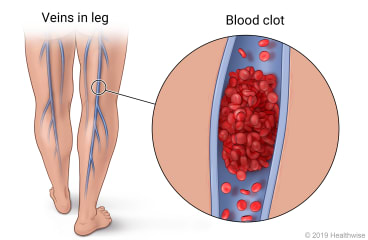What is a deep vein thrombosis (DVT)?

A deep vein thrombosis (DVT) is a blood clot (thrombus) in a deep vein, usually in the legs. A DVT can be dangerous because it can break loose and travel through the bloodstream to the lungs. There it can block blood flow in the lungs (pulmonary embolism). This can be life-threatening.
What are the symptoms?
DVT often doesn't cause symptoms. Or it may cause only minor ones. When symptoms happen, they include:
- Swelling in the affected area of the leg or arm.
- Redness and warmth in the affected area.
- Pain or tenderness. You may have pain only when you touch the affected area or when you stand or walk.
Sometimes a pulmonary embolism is the first sign that you have DVT.
If your doctor thinks you may have DVT, you will probably have an ultrasound test. You may have other tests as well.
What causes deep vein thrombosis (DVT)?
Causes of a blood clot in a deep vein (DVT) include:
- Slowed blood flow. This can happen when you're not active for long periods of time. For example, clots can form if you are paralyzed, are confined to bed, or must sit while on a long flight or car trip.
- Abnormal clotting problems that make the blood clot too easily or too quickly. This may be caused by certain health problems, such as cancer or a genetic clotting disorder. Pregnancy, hormonal birth control, and hormone therapy can also make blood more likely to clot.
- Surgery or an injury to the blood vessels. Blood is more likely to clot in veins shortly after they are injured.
How can you prevent DVT?
- Exercise your lower leg muscles to help blood flow in your legs. Point your toes up toward your head so the calves of your legs are stretched, then relax and repeat. This is a good exercise to do when you are sitting for long periods of time.
- Get out of bed as soon as you can after an illness or surgery. If you need to stay in bed, do the leg exercise noted above every hour when you are awake.
- Use special stockings called compression stockings. These stockings are tight at the feet with a gradually looser fit on the leg. Many doctors recommend that you wear compression stockings during a journey longer than 8 hours.
- Take breaks when you are on long trips. Stop the car and walk around. On long airplane flights, walk up and down the aisle hourly, and flex and point your feet every 20 minutes while sitting.
- Take blood-thinning medicines after some types of surgery if your doctor recommends it. Blood thinners also may be used if you are likely to develop clots.
How is DVT treated?
Treatment for DVT usually involves taking blood thinners. They prevent blood clots by increasing the time it takes a blood clot to form. Blood thinners also help prevent existing blood clots from getting larger while the body reabsorbs them.
Your doctor also may suggest that you prop up or elevate your leg or arm when possible, take several walks a day, and wear compression stockings. These measures may help reduce the pain and swelling that can happen with DVT.
Follow-up care is a key part of your treatment and safety. Be sure to make and go to all appointments, and contact your doctor if you are having problems. It's also a good idea to know your test results and keep a list of the medicines you take.
Where can you learn more?
Go to http://www.healthwise.net/patientEd
Enter X941 in the search box to learn more about "Learning About Deep Vein Thrombosis".
Current as of: October 2, 2025
Author: Ignite Healthwise, LLC Staff
Clinical Review Board
All Ignite Healthwise, LLC education is reviewed by a team that includes physicians, nurses, advanced practitioners, registered dieticians, and other healthcare professionals.

